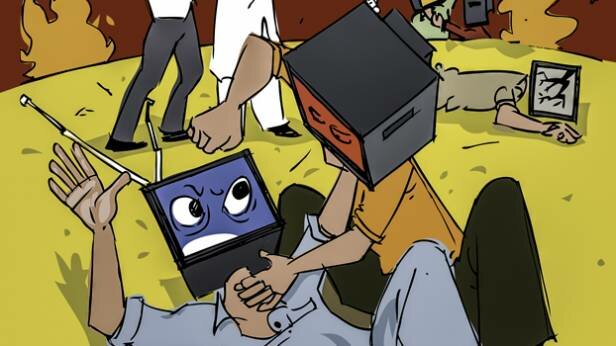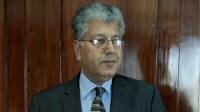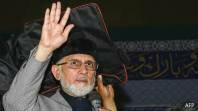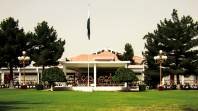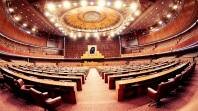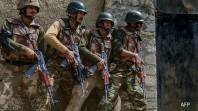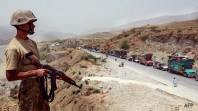The country’s number one news channel and premier intelligence agency have more in common than either is likely to admit this summer. Both crave power, privilege, money, unwavering support from the civilian government and have an overall low threshold for criticism; both also have a reputation for not playing fair.
The epic battle of egos being played out on the streets and airwaves right now, with little truth or perspective, should make one thing very clear: the motivation for either side has nothing to do with upholding the ethics of journalism or the sanctity of state institutions. It is about coming out on top of the rubble.
It’s a struggle between the old corridors of power and the new, a struggle to write narratives and decide facts, a struggle for state patronage and public imagination. To be sure, things between Geo and the security establishment have been at an uneasy standstill for a while. All they needed was a spark, one incident to ignite a skirmish.
The tragic shooting of Hamid Mir provided that ignition, and what a skirmish it’s turned out to be, with mudslinging and irresponsible accusations from all possible corners. In a way this is an event 67 years in the making, since no genuine effort for ethical training or accountability has been made with regards to the institution of the press since the creation of Pakistan.
Press for the State, By the State:
“There are two reasons why Pakistani media is the way it is,” says a member of government on condition of anonymity. “The first reason is historical. The first newspaper in United India was published in the English language by James Hickey whose sole task was to criticize the East India Company - now whether he did it to reform the Company or blackmail them, one does not know! But that model was taken up by every newspaper that came after it in Bengali, Hindi, Urdu and other languages. Under British rule, media was antagonistic and played the role of the opposition. This pattern continued after partition as well. So instead of news-oriented coverage, explanatory comments, in Pakistan a very strong tradition of critical media developed.”
After partition, it was considered vital to co-opt this tradition to work along with the newly formed state, instead of working against fledgling administrative institutions.
“In U.S. and Britain, growth of political theory and capitalist economy were independent of the state,” he continues. “Media was ultimately a business, and the state in these countries had nothing to do with the economy of sustaining the paper. Hence the media evolved in a truly independent fashion. Here, media houses were created or sustained by the state. There was state patronage, public money was used, advertisements of government departmental clients, like CDA, NHA, PIA, OGDC, PID, etc. and print quota - a very powerful tool till pre-Musharraf time, when it was finally abolished.”
This influence lies very deep at the heart of corporate media. “All the current big media houses became big this way. One paper always sided with dictatorial regimes. One was the custodian of ‘Pakistaniat’. There was no industry or capital to sustain independent publishing. Patronage became the pattern of business in media.”
Even Jinnah was not immune to its sway. Zamir A. Niazi in his book ‘The Press in Chains’ (1986) quotes reporter M. A. Shakoor, who worked in the Dawn newsroom when it’s inaugural issue of 15th August 1947 was being prepared, as saying, “the Quaid-e-Azam had come to Karachi...and wanted a newspaper of his own. He asked Yusuf Haroon to use the press for Dawn, instead of a new newspaper. Haroon explained that the press was not his own, but belonged to a joint stock company of which he was a director. Whereupon the Quaid suggested that the management could remain with the company, the Pakistan Herald Publications, while the editorial policy would be his, through Liaquat Ali Khan.”
Of course, as history panned out, Jinnah never got the opportunity to assert power through media, not as Liaquat Ali Khan would come to do in the four years he was the Prime Minister, even muzzling portions of Fatima Jinnah’s radio speech on her brother’s death anniversary. It just drives home the point that the dissemination of information is considered vital in consolidating power.
Thus, a section of the press, including editors and senior journalists, called Khawaja Nazmuddin ‘Quaid-e-Qillat’, rallied against Bogra when he granted Bengali the status of second national language, supported the anti-Ahmedi riots, wanted Ayub Khan to declare himself president for life, never questioned the blatant discrimination of the One Unit formula and supported Zia-ul-Haq and his Afghan policy, which now the same editors and journalists blame for the present day militant insurgencies.
When Absar Alam and Hamid Mir petitioned the Supreme Court in 2012 to hold media houses and senior journalists accountable for their incomes, it was widely felt as a case of too little too late. Ensuing revelations by business tycoons like Malik Riaz, and the mentioning of many ministries, shocked the general public but it wasn’t news to the media world itself, for them it was something that had always been going on behind the curtains, behind the newsrooms, it was all part of the job.
Even the Supreme Court followed a historical pattern of inaction, some thirty years earlier, in 1972, during the trial of Ayub Khan’s Information Secretary it was revealed that many journalists and editors had been in the pay of various official institutions in Ayub’s tenure as well as Zulfiqar Ali Bhutto’s. Nothing concrete was done about it then (names of beneficiaries were expunged from court proceedings), and no further investigation has been done now following the ‘on-the-payroll’ list and Media Commission Report of 2013. The more things change, the more they remain the same.
Media Wars - When Wolves Cry Foul:
The single-most important function of print and broadcast media – that it is a custodian of facts - has taken a backseat to what can only be described as merging pseudo, superficial analysis with amateurish story-telling to heighten the dramatic quality of news entertainment. Deception, the concealment of information, misquotations, media trials, selective screen time; where in other countries the media is expected to inform and engage, here its only function is to mislead, to pander to one agenda or the other.
As the nation’s largest news channel, Geo finds its self alone in a minefield of its own making, it would be good to remember that powerful organizations holding divergent interests have rarely gotten along in Pakistan. When the planted Malik Riaz interview at Dunya TV was exposed, the channel cried conspiracy, pointing its finger at Geo in particular, saying that the big media group wanted to curb Dunya’s growing popularity. Even though the public didn’t buy the story, many of Dunya TV’s disgraced ratings-magnate anchors soon found themselves on rival airwaves, picking up hefty paychecks again and rebuilding political clout.
Mubashar Lucman’s show on ARY has become a launch pad for anti-Geo vitriolic this year, something that never should’ve been allowed by PEMRA in the first place, turning, in response, Geo News into a corporation focused on legal victories and public relations, instead of delivering news.
You can’t imagine Fox News and CNN, no matter what the differences in their slants and ideologies, going for each other’s jugulars bringing embarrassment on their own professions in the process.
“Basically the rivalry between Geo and ARY is the result of corporate media culture where their commercial interests are more important than their professional interests...and it has to do with other businesses of the media channels, the moneyed worth of which is higher than the channel itself. For e.g. you will see a lot of stories in ARY about Jehangir Siddiqui who is Geo owner Shakil-ur-Rehman’s samdhi and has a business rivalry with Karim Dhedhi – a man with many friends at ARY. On the other hand Jang routinely publishes stories against Dhedhi,” says Mazhar Abbas, a media analyst from Karachi.
“People with businesses in education and property have invested millions in news networks, whether in print or broadcast,” he continues. “Their main interest is to serve and protect the businesses, gain direct contact with ordinary people and develop influence. You want to be influential. Once you gain clout, then of course you can get direct benefits from government policies, not just in known businesses, but in startups and new development projects, big money projects, that need both industrial linkages, transport, public relations and advertisement.”
But while these corporate media rivalries might be a new development, the disunity of journalists has always been a given. In the ’50s, there were two rival organizations representing the interests of ‘journalistic integrity’: Pakistan Newspapers Editors Conference (PNEC) headed by Dawn’s editor Altaf Hussain (no relation to the leader of the MQM) and Council of Pakistan Editors (CPE) by Nawa-i-Waqt’s Hamid Nizami. Editors from both organizations would frequently change loyalties and jump ship overnight.
“Media rivalries have always existed,” says Abbas recounting an episode from 1949 when in a never-before-or-seen-since joint editorial titled ‘Treason’ by seventeen editors of 16 papers - including Faiz Ahmed Faiz, Chiragh Hasan Hasrat and Mir Khalil-ur-Rehman - demanded penal action against the head of ‘Civil and Military Gazette’ and immediate suspension of its publication - a campaign launched by ideological opposites Dawn and Nawa-i-Waqt.
The Gazette had published a report that a compromise was at hand between Pakistan and India over Kashmir. “The paper was forced to submit an unconditional apology and that was that,” finishes Abbas.
It’s another story that the Gazette never recovered from the scandal, effectively putting it out of business and rendering its staff unemployed.
In simpler times, big groups like Jang and Nawa-i-Waqt even had a territorial understanding: the former would not publish from Lahore and the latter would not enter Karachi. But political and economic changes in Pakistan created new opportunities for media groups. Territories became less physical and more ideological, some media groups leaned far right and others tried to stick to a centralist political and social world view. Still, one thing remained the same; they continued to try and build their successes on their rival’s failures, one man’s news was another man’s poison.
Reporter thy name is Profiteer:
Douglas Cater, a journalist who turned politician for a while in the ‘60s, dubbed the press as the ‘fourth branch of government’. His view was that reporters exercise independent political power, and are as much shapers of events as any state institution. “The reporter can choose,” he wrote, “from among the myriad events that seethe beneath the surface of government which to describe, which to ignore. He can illuminate policy or prematurely expose it, thus causing its destruction. At his worst, operating with arbitrary and faulty standards, he can be an agent of disorder and confusion. At best he can be a creative influence on politics.”
Unlike the U.S., where the average journalist is a middle-aged, highly educated, underpaid liberal, Pakistan is full of young, inexperienced, moderately literate, conservative and even more underpaid journalists who might venture into the field for different reasons, but end up almost ubiquitously scrounging for payoffs and handouts to publish or withhold stories.
“I call it the LMG - the Loot Maar Group,” says Nauman Khan Babar, the 29-year old Multan bureau chief of Dunya TV, who was previously with Express News. This is his fifth channel. “See, smaller channels do not pay their reporters. So what a cameraman or reporter does is make footage: of a dairy factory, where the milk is not fresh, the butter is not right etc. and then they blackmail the owner into paying money to stop the footage. They normally earn ten to twenty thousand rupees per case. On a daily basis a camera man earns two to three thousand just by making extra footage.”
He adds, “This is the reality for 90% of all reporting! They create events. It is being said about the girl in Muzaffargarh (alleged victim of gang-rape who died in an act of self-immolation on 14th March 2014), that a reporter told her to throw a bit of petrol on herself to garner more attention, saying ‘we will save you, do not worry’. The girl was wearing silk clothes, the fire got out of control and that was that.”
There is no way to substantiate this claim of Khan, but it does not stop him. He continues, “When a journalist goes to cover a protest, at the end of it, he starts to scratch his stomach - the other party understands that he wants money...crime reporters get a monthly stipend from the local SHO. We call it ‘Aakrra’, if there are gambling dens in the area of the local police station, a reporter is paid money from the station for not writing about them.”
Syed Alamdar Naqvi, Deputy DG Press Information Department, is about to retire this July after 30 years of service. Right now, he has an additional charge of the National Press Trust as well. There is nothing he has not seen. “It is not the media’s job to pour oil over wounds. But when Hamid Mir was editor of Pakistan, a newspaper from Islamabad, the headline of that paper after the killing of Shoaib Nadeem, a Sunni religious leader from Wah Cantt, was ‘Sunni Muslims burn four Imam Bargah’. There was a reaction but it was wrong to put it like that, the intention was to stoke the embers for some more flames.”
Similarly, in the week after the Rawalpindi Raja Bazaar incident (15th Oct, 2013) where Sunni shops and Madrassahs were torched, one of the most reviled sectarian leaders in the country was invited to give his views on one private channel. The broadcast was cut short because five minutes into the program the leader declared that, “Shias are Wajib-ul-Qatal, this is what every Aalim of authority has always adhered to”. The channel didn’t decide to forego the transmission because hatred and violence was being spewed against a segment of Pakistan’s population, it decided to forego it because the nature of the hate filled speech violated PEMRA regulations.
Then there are the petty quarrels of noted journalists and anchors played out on television screens during prime time hours: Talat Hussain and Najam Sethi calling each other spies, Ansar Abbasi having a go at Saleem Safi in the ‘Letter to Taliban’ fiasco, Shahzeb Khanzada in a punching row with Javed Chaudhry, Haroon Rasheed and Iftikhar Ahmed swapping an ideological sword fight over Bhutto; the real casualty of all this unethical and unprofessional behaviour is the public trust in journalism itself.
Belling the Cat
At the time of partition, there were ten major newspapers in the East and West wings collectively. Many laws since then have been applied to regulate the press and broadcast media.
From the Public Safety Ordinance of 1948 to the West Pakistan Press and Publications Ordinance of 1963; the rampant handing out of declarations for print during the Bhutto years to the over-night checking of next day editions by government officials during the Zia era; the Press Council of Pakistan Ordinance 2002, and The Press, Newspapers, News Agencies and Books Registration Ordinance 2009 have all swung between cajoling and controlling the media. Today, 15 Acts and Ordinances directly or indirectly control quality of information on mass media.
And yet here it is, spiraling a little more out of control every day. There are 609 dailies published across Pakistan, many of them illegally. There are ways to circumvent rules to get license permits to start a paper or magazine long before the file reaches Audit Bureau of Certification. It takes but one verbal order of a minister to change the circulation figure from 4,000 to 40,000 so that the publication makes more money off government advertisements. Then there is the unethical practice by owners to sell the publication on after getting the name on the Media List. The 181-page Media Commission Report 2013 lamented the dummy publications as well as channels that had not obtained license and yet operated freely. Of the 89 licensed endeavours, twenty-nine are news channels, working to carve out their own hegemony over the airwaves.
While issues of legality linger on, new power brokers are emerging on the media playground every day, if Geo takes a tumble there are ten more waiting in line to take charge of the news industry even more ruthlessly; the country should brace itself for many more battles of egos fought on pages and airwaves, one can only hope that unlike the news givers, the consumers of biased coverage have the sense to responsibility handle information.
Disclaimer: The piece does not aim to undermine the professional working journalists or genuine threats to their life in the line of duty.
The writer is a journalist based in Islamabad.

